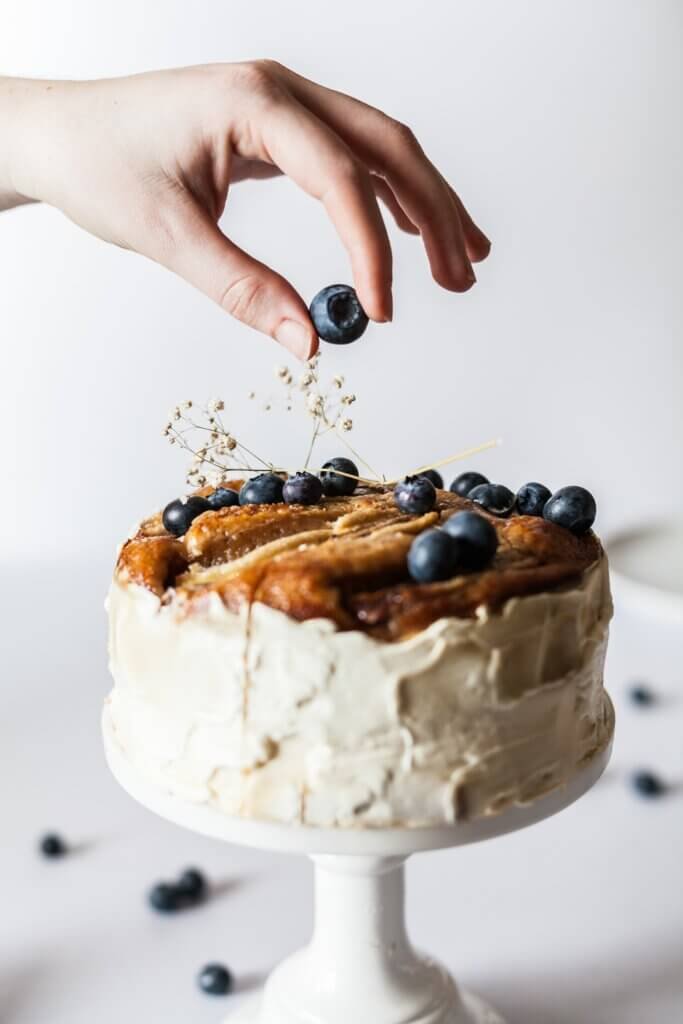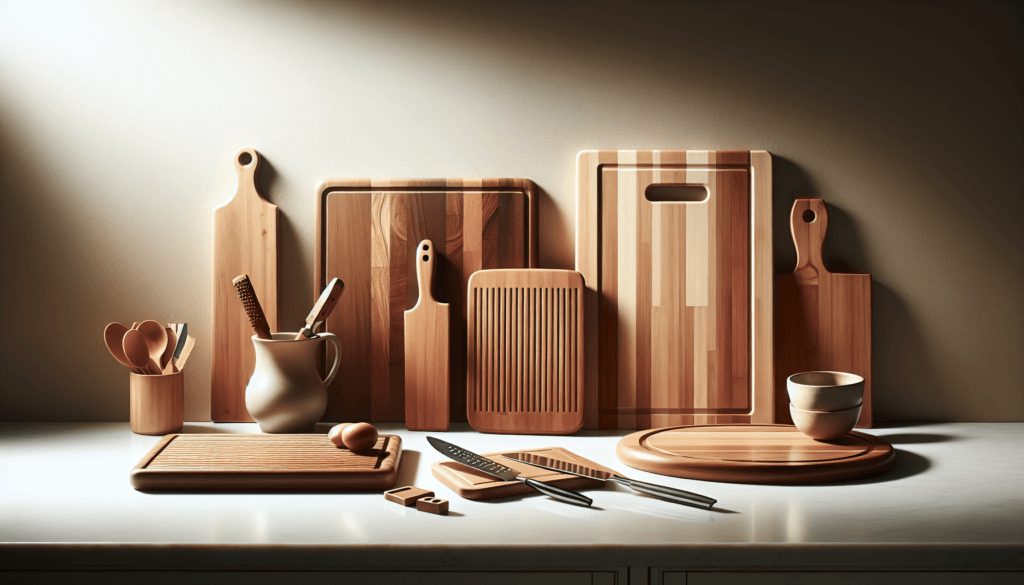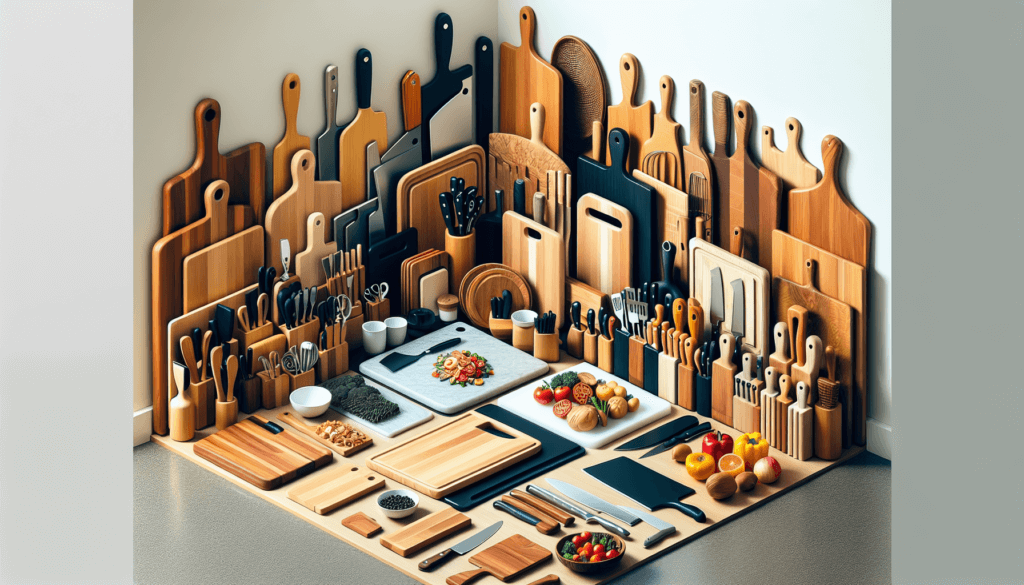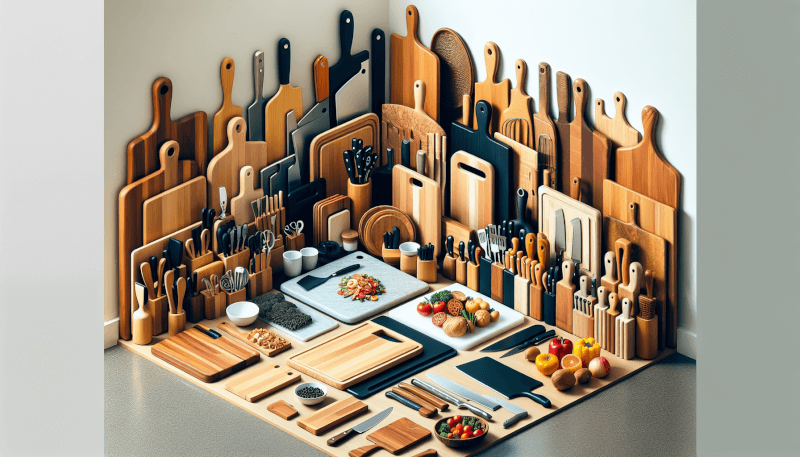When it comes to preparing meals in your kitchen, having the right tools is essential. And one of the most important tools for any home cook is a reliable cutting board. But with so many options available on the market, how do you choose the best one for your kitchen? From considering the material and size to understanding the impact on your knives, this article will guide you through the process of selecting the perfect cutting board to enhance your culinary experience. With our helpful tips and insights, you’ll soon be cutting and chopping with ease, all while protecting your countertops and extending the lifespan of your knives. So let’s get started on finding the best cutting board for you!

Material
Wood
Wood is a classic and popular choice for cutting boards due to its natural beauty and durability. It is gentle on knives, which helps to keep them sharper for longer. Wood cutting boards are also known for their antimicrobial properties, preventing the growth of bacteria. They may require regular maintenance, such as oiling or waxing, to keep them in optimal condition. However, some types of wood, like bamboo, are more resistant to water damage and less prone to warping or cracking. Wood cutting boards are available in various sizes, thicknesses, and types of wood, allowing you to choose the one that suits your kitchen and cooking needs best.
Plastic
Plastic cutting boards are affordable, lightweight, and easy to clean. They come in a range of colors, making it easier to designate specific boards for different types of food, reducing the risk of cross-contamination. Plastic cutting boards are generally dishwasher safe, making them a convenient choice for busy kitchens. However, they can dull knives more quickly and are more susceptible to cuts and scratches, which can harbor bacteria if not properly cleaned. Plastic cutting boards are available in different sizes and thicknesses, allowing you to choose one that fits your countertop and storage space.
Bamboo
Bamboo cutting boards have gained popularity in recent years due to their sustainability and durability. Bamboo is a fast-growing grass, making it an eco-friendly choice for those concerned about the environment. It is harder than most types of wood, providing a sturdy cutting surface that is gentle on knives. Bamboo cutting boards are also resistant to water damage and less likely to absorb odors or stains. However, they may require occasional oiling to maintain their smooth surface and prevent cracking. Bamboo cutting boards come in various sizes and can add a natural and modern look to your kitchen.
Glass
Glass cutting boards are known for their sleek and hygienic appearance. They are non-porous, making them resistant to bacteria, odors, and stains. Glass cutting boards are easy to clean and dishwasher safe. However, they can be harsh on knives, causing them to dull more quickly. Glass cutting boards are available in a variety of sizes and patterns, making them a trendy addition to any kitchen decor.
Composite
Composite cutting boards are made from a combination of materials, usually plastic or resin, with wood fibers or bamboo. This fusion creates a cutting board that combines the benefits of both wood and plastic. Composite cutting boards are typically knife-friendly, easy to clean, and resistant to bacteria. They come in various sizes, making them suitable for different kitchen setups. Although composite cutting boards can be more expensive than other options, they often offer long-term durability and value for money.
Size
Consider your countertop
When choosing a cutting board, consider the size of your countertop. It should be large enough to provide ample space for chopping, slicing, and dicing ingredients without overcrowding your work area. A cutting board that is too large for your countertop can be cumbersome and make it difficult to maneuver around the kitchen. On the other hand, a cutting board that is too small may require you to transfer food to another surface, leading to potential messes and increased cleanup time.
Available storage space
Take into account the available storage space in your kitchen when selecting a cutting board. If you have limited cabinet or countertop space, opt for a cutting board that can be easily stored, such as a slim and lightweight one. Consider collapsible or multi-purpose cutting boards that can save storage space. Alternatively, you could choose a cutting board with a built-in hanging hole or one that can double as a serving board, providing you with versatility and practicality.
Meal prep needs
Think about your meal prep needs when choosing a cutting board. If you frequently prepare large quantities of food, a larger cutting board may be preferable. Alternatively, if you often work with smaller ingredients or have limited kitchen space, a smaller cutting board may be more suitable. Additionally, consider the thickness of the cutting board. A thicker board provides stability and prevents it from sliding around during use, while a thinner board may be more lightweight and easier to maneuver.
Durability
Resistance to cuts and scratches
One important factor to consider when choosing a cutting board is its resistance to cuts and scratches. A durable cutting board should be able to withstand the sharp blade of a knife without leaving deep marks or grooves. Wood and composite cutting boards are generally more forgiving in this regard, as their surfaces are softer and less prone to knife marks. Plastic and glass cutting boards, while more susceptible to cuts and scratches, can still provide sufficient durability with proper care and maintenance.
Ability to withstand heavy chopping
If you frequently engage in heavy chopping or cutting tasks, it’s essential to choose a cutting board that can withstand the impact. Look for a cutting board that is thick and sturdy to prevent it from warping or cracking under pressure. Wood and bamboo cutting boards are known for their strength and can handle heavy chopping. Composite cutting boards, which often combine the durability of plastic or resin with the sturdiness of wood fibers, are also an excellent choice for heavy-duty use. Plastic cutting boards may be more prone to warping or showing signs of wear and tear over time.
Longevity
Consider the longevity of a cutting board when making your decision. A high-quality cutting board should be able to withstand regular use over an extended period without losing its structural integrity. Wood, bamboo, and composite cutting boards are generally durable and can last for many years with proper care. Plastic cutting boards, while less prone to cracking or warping, may wear out quicker and require more frequent replacement. Glass cutting boards are relatively durable but are more susceptible to breaking if handled roughly.
Maintenance
Ease of cleaning
Cleaning your cutting board regularly is essential for maintaining hygiene in your kitchen. Consider the ease of cleaning when choosing a cutting board. Wood and bamboo cutting boards should be washed by hand with warm water and mild soap, as they can warp or crack if left to soak or placed in the dishwasher. Plastic and composite cutting boards are generally dishwasher safe, making them convenient and easy to clean. Glass cutting boards can be cleaned with ease using regular dish soap and a sponge or placed in the dishwasher.
Maintenance requirements
Different cutting board materials have varying maintenance requirements. Wood and bamboo cutting boards may require periodic oiling or waxing to keep their surfaces smooth and prevent water damage or cracking. Regularly applying a food-grade mineral oil or beeswax will help maintain the board’s quality and extend its lifespan. Plastic and composite cutting boards typically require less maintenance, primarily requiring thorough cleaning after each use. Glass cutting boards have minimal maintenance requirements, usually limited to removing any food residue and drying them thoroughly to prevent water spots.
Dishwasher compatibility
If you prefer the convenience of a dishwasher, check whether your chosen cutting board is dishwasher safe. Plastic and composite cutting boards are generally safe to put in the dishwasher’s top rack. However, wood and bamboo cutting boards should be washed by hand, as high temperatures and prolonged exposure to water in the dishwasher can damage or warp them. Glass cutting boards are typically dishwasher safe but may be prone to chipping or breaking if not handled with care.

Hygiene
Antimicrobial properties
When it comes to food safety, the antimicrobial properties of a cutting board are essential. Wood cutting boards, especially those made from certain types of wood like bamboo, have natural antimicrobial properties that help prevent the growth of bacteria. These properties can reduce the risk of cross-contamination and keep your kitchen environment safer and healthier. Plastic cutting boards may be less naturally antimicrobial, but regular, thorough cleaning can help maintain their hygiene. Glass cutting boards are non-porous, making them resistant to bacteria growth and easy to clean.
Resistance to bacterial growth
Cutting boards that resist bacterial growth are crucial to maintaining a hygienic kitchen. Wood and bamboo cutting boards are known for their ability to inhibit the growth of bacteria, thanks to their natural antimicrobial properties. Plastic cutting boards can also resist bacterial growth if they are thoroughly cleaned and dried after each use. Glass cutting boards are non-porous, minimizing the chance of bacteria penetrating the surface. Remember to clean your cutting board after each use to ensure a safe and bacteria-free food preparation environment.
Non-porous surface
A non-porous surface is beneficial for cutting boards as it prevents the absorption of liquids, odors, and stains, reducing the risk of bacteria growth. Glass cutting boards have a non-porous surface that is easy to clean and resistant to odors and stains. Wood and bamboo cutting boards are slightly porous but can still resist liquids and odors to some extent. Plastic and composite cutting boards may have slight porosity, but regular cleaning helps maintain their non-porous surface and prevent bacterial growth.
Knife-Friendly
Avoiding excessive knife dulling
One important consideration when choosing a cutting board is its impact on knife sharpness. Cutting boards that are too hard or abrasive can dull knife blades more quickly, making it necessary to sharpen them more frequently. Wood and bamboo cutting boards, with their softer surfaces, are considered more knife-friendly, helping to maintain knife sharpness for longer. Plastic cutting boards are generally less forgiving on knives and can cause them to dull more quickly. Glass cutting boards are known to be abrasive and can significantly accelerate the dulling of knife edges.
Gentle on blade edges
To keep your knives in top condition, choose a cutting board that is gentle on blade edges. Wood and bamboo cutting boards are softer and provide a forgiving surface, minimizing the impact on knife edges. Composite cutting boards often combine the knife-friendly qualities of wood with the durability of plastic or resin, offering a good balance. Plastic cutting boards can be harsh on knife blades, leading to faster dulling. Glass cutting boards are the harshest on knife edges and should be avoided if you want to maintain the sharpness of your knives.
Avoiding deep knife marks
Deep knife marks can harbor bacteria and make a cutting board less hygienic. Wood and bamboo cutting boards tend to show fewer knife marks due to their self-healing properties. The fibers in the wood or bamboo close up over time, minimizing the depth and visibility of knife marks. Plastic cutting boards may develop deep cuts and scratches more easily, which can be difficult to clean thoroughly. Glass cutting boards should be avoided if you want to prevent knife marks, as their hard surface is more prone to noticeable scratches.

Stability
Anti-slip properties
Stability is crucial for safe and efficient cutting. Look for a cutting board with anti-slip properties to ensure it stays in place during use. Cutting boards made from wood, bamboo, or composite materials often have natural anti-slip properties due to their weight and texture. Rubber or silicone grips on the corners of plastic cutting boards can also provide stability and prevent them from sliding on your countertop. Glass cutting boards may require additional measures, such as placing a damp kitchen towel underneath, to prevent them from slipping during use.
Weight and thickness
Consider the weight and thickness of the cutting board when assessing its stability. A heavier cutting board is less likely to slide or move while cutting. Wood, bamboo, and composite cutting boards are generally heavier than plastic or glass options, providing added stability. However, if portability is a priority, a lighter plastic cutting board might be more suitable for you. The thickness of the cutting board also affects its stability. Thicker boards are less prone to flexing or bending during use, ensuring a stable cutting surface.
Grip on countertop
To maintain stability, the cutting board should have a good grip on your countertop. Wood, bamboo, and composite cutting boards typically provide a natural grip due to their textured surface. Plastic cutting boards with rubber or silicone grips on the corners can prevent slippage and ensure a secure grip on your countertop. Glass cutting boards may require additional measures to enhance their grip, such as using non-slip mats or damp towels underneath.
Functionality
Versatility for different food types
Consider the versatility of the cutting board for different food types. Some cutting boards may be more suitable for specific ingredients or tasks. Wood, bamboo, and composite cutting boards are generally versatile and can handle various food types, including fruits, vegetables, meats, and bread. Plastic cutting boards are also versatile, but they may develop deep knife marks over time, making thorough cleaning more challenging. Glass cutting boards are suitable for most ingredients, but they may be harsh on knife edges and more prone to breakage.
Availability of juice grooves
Juice grooves are a practical feature on cutting boards, especially when handling juicy or moist ingredients. They help to collect and contain the juices, reducing mess and preventing cross-contamination. Wood, bamboo, and composite cutting boards often have carved-in juice grooves that channel excess liquid away from the cutting surface. Plastic cutting boards may also have built-in juice grooves, but they may not be as effective at preventing spills. Glass cutting boards, due to their flat and non-porous surface, may not have juice grooves.
Special features (handles, measurement guides)
Consider any special features that might enhance the functionality of your cutting board. Some cutting boards come with built-in handles, making them easier to carry and transport. Handles can also act as a hanging hole, allowing you to store the cutting board conveniently. Measurement guides etched into the cutting board can be helpful when following specific recipes or needing accurate portioning. While wood, bamboo, and composite cutting boards are more likely to have handles and measurement guides, plastic and glass cutting boards may have some options available as well.

Aesthetics
Match with kitchen decor
A cutting board can be a stylish addition to your kitchen decor. Consider choosing a cutting board that matches or complements the overall aesthetic of your kitchen. Wood cutting boards have a warm and natural appearance that can complement various kitchen styles, from traditional to modern. Bamboo cutting boards offer a similar aesthetic and are often preferred for their sustainability. Plastic cutting boards come in a variety of colors, allowing you to choose one that suits your kitchen’s theme. Glass cutting boards can add a sleek and contemporary look to your countertops.
Variety of colors and patterns
If you want to add a pop of color or pattern to your kitchen, consider a cutting board that offers a variety of options. Plastic cutting boards are available in numerous vibrant colors, allowing you to choose one that matches or contrasts with your kitchen decor. Some plastic cutting boards even feature patterns or designs. Wood and bamboo cutting boards have a more natural and subdued color palette, typically ranging from light to dark brown. Glass cutting boards come in various patterns and designs, offering unique visual appeal.
Natural or modern look
Decide whether you prefer a cutting board with a natural or modern look. Wood and bamboo cutting boards provide a rustic and traditional aesthetic, adding warmth and character to your kitchen. Composite cutting boards often offer a blend of natural and modern elements, featuring wood fibers or bamboo combined with plastic or resin. Plastic cutting boards are available in sleek and modern designs, while glass cutting boards provide a contemporary and minimalist look.
Price
Budget considerations
When choosing a cutting board, it’s important to consider your budget. Cutting boards come in a wide range of prices, depending on the material, size, and brand. Wood and bamboo cutting boards tend to be on the higher end of the price spectrum, reflecting their durability and natural beauty. Plastic cutting boards are generally more affordable, making them a budget-friendly option. Composite cutting boards often fall in the mid-range of prices, offering a balance between durability and cost. Glass cutting boards can vary in price, depending on their size and design.
Long-term investment
Think of your cutting board purchase as a long-term investment. While more expensive cutting boards may have a higher upfront cost, they often offer greater durability and longevity, potentially saving you money in the long run. High-quality wood, bamboo, or composite cutting boards can last for many years with proper care and maintenance. Cheaper plastic or glass cutting boards may wear out more quickly and require more frequent replacement, resulting in higher long-term costs.
Value for money
Consider the overall value for money when deciding on a cutting board. Evaluate the features, durability, functionality, and aesthetics of the cutting board in relation to its price. A cutting board that offers a good balance of quality and affordability may provide the best value for money. Compare different options within your budget range and choose the one that best meets your needs, both in terms of performance and cost-effectiveness. Keep in mind that investing in a durable and high-quality cutting board can enhance your cooking experience and contribute to a safer and more efficient kitchen.



